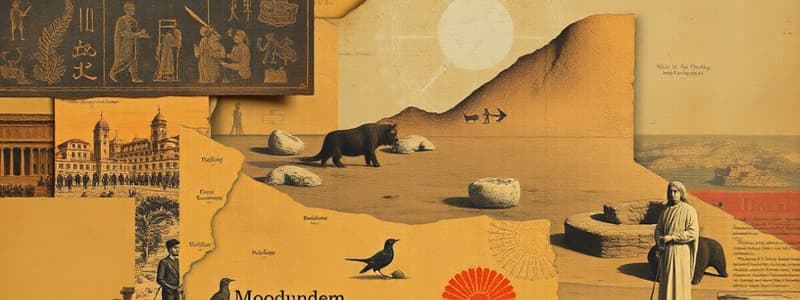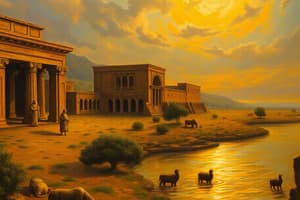Podcast
Questions and Answers
What does the word "Mesopotamia" mean in Greek?
What does the word "Mesopotamia" mean in Greek?
Between the two rivers
What are the two rivers that define Mesopotamia?
What are the two rivers that define Mesopotamia?
- Nile and Euphrates
- Nile and Tigris
- Tigris and Euphrates (correct)
- Indus and Ganges
What are the three major geographic features that surround the Fertile Crescent?
What are the three major geographic features that surround the Fertile Crescent?
Mountains, deserts and the sea.
What type of soil is found in the Fertile Crescent?
What type of soil is found in the Fertile Crescent?
What are the three similarities in location between the cities of Babylon and Ur?
What are the three similarities in location between the cities of Babylon and Ur?
What are some of the reasons why a tribe leader would choose to settle in the Fertile Crescent?
What are some of the reasons why a tribe leader would choose to settle in the Fertile Crescent?
The Mesopotamian Civilization was primarily based on agriculture and trade.
The Mesopotamian Civilization was primarily based on agriculture and trade.
What were the three areas of development that made up Mesopotamian civilization?
What were the three areas of development that made up Mesopotamian civilization?
How did Mesopotamian people irrigate their land?
How did Mesopotamian people irrigate their land?
The Mesopotamian civilization was able to grow more food than they could eat. They used this surplus to trade.
The Mesopotamian civilization was able to grow more food than they could eat. They used this surplus to trade.
What were the primary forms of payment used in trade in Mesopotamia?
What were the primary forms of payment used in trade in Mesopotamia?
What were ziggurats and why were they built?
What were ziggurats and why were they built?
What were the three major beliefs that shaped the religious practices of the Mesopotamian people?
What were the three major beliefs that shaped the religious practices of the Mesopotamian people?
The Mesopotamian gods were believed to be perfect and unchanging.
The Mesopotamian gods were believed to be perfect and unchanging.
What is a cuneiform writing system?
What is a cuneiform writing system?
How did trade promote the development of writing in Mesopotamia?
How did trade promote the development of writing in Mesopotamia?
What was the purpose of the hanging gardens of Babylon?
What was the purpose of the hanging gardens of Babylon?
What material was used as a building material in Mesopotamia?
What material was used as a building material in Mesopotamia?
What was the major political change that occurred in Mesopotamia around 2100 BC?
What was the major political change that occurred in Mesopotamia around 2100 BC?
The Sumerians believed that their legal code was divinely inspired.
The Sumerians believed that their legal code was divinely inspired.
Who created the Code of Hammurabi?
Who created the Code of Hammurabi?
What are some of the major kingdoms that existed in Mesopotamia from 4000BC onwards?
What are some of the major kingdoms that existed in Mesopotamia from 4000BC onwards?
What was the significance of the Sumerian civilization?
What was the significance of the Sumerian civilization?
Mesopotamia was politically stable throughout its history.
Mesopotamia was politically stable throughout its history.
What is the difference between primary and secondary sources, and how do they relate to the study of history?
What is the difference between primary and secondary sources, and how do they relate to the study of history?
Why are primary sources important for the study of history?
Why are primary sources important for the study of history?
Once destroyed or lost, primary sources can easily be replaced.
Once destroyed or lost, primary sources can easily be replaced.
Flashcards
Mesopotamia
Mesopotamia
The land located between the Tigris and Euphrates Rivers, known for its fertile soil and rich agriculture.
Fertile Crescent
Fertile Crescent
A crescent-shaped area in the Middle East, characterized by fertile land and abundant resources.
Irrigation System
Irrigation System
A system of canals and dams used by Mesopotamian civilizations to irrigate their land and increase agricultural yields.
Agriculture
Agriculture
Signup and view all the flashcards
Trade
Trade
Signup and view all the flashcards
Silver Shekels
Silver Shekels
Signup and view all the flashcards
Duck Weights
Duck Weights
Signup and view all the flashcards
Ziggurats
Ziggurats
Signup and view all the flashcards
Cuneiform
Cuneiform
Signup and view all the flashcards
Clay Tablets
Clay Tablets
Signup and view all the flashcards
Reed Pens
Reed Pens
Signup and view all the flashcards
Polytheism
Polytheism
Signup and view all the flashcards
Temple
Temple
Signup and view all the flashcards
Please the Gods
Please the Gods
Signup and view all the flashcards
Gods Behaving Like Humans
Gods Behaving Like Humans
Signup and view all the flashcards
Supernatural Powers
Supernatural Powers
Signup and view all the flashcards
Pazuzu
Pazuzu
Signup and view all the flashcards
Social Structure
Social Structure
Signup and view all the flashcards
Code of Ur-Nammu
Code of Ur-Nammu
Signup and view all the flashcards
Code of Hammurabi
Code of Hammurabi
Signup and view all the flashcards
Stone Pillar of Hammurabi
Stone Pillar of Hammurabi
Signup and view all the flashcards
City-State
City-State
Signup and view all the flashcards
Monarchy
Monarchy
Signup and view all the flashcards
Mesopotamian Civilizations
Mesopotamian Civilizations
Signup and view all the flashcards
Hanging Gardens of Babylon
Hanging Gardens of Babylon
Signup and view all the flashcards
Akkadian Empire
Akkadian Empire
Signup and view all the flashcards
Babylonian Civilization
Babylonian Civilization
Signup and view all the flashcards
Assyrian Civilization
Assyrian Civilization
Signup and view all the flashcards
Neo-Assyrian Empire
Neo-Assyrian Empire
Signup and view all the flashcards
Neo-Babylonian Empire
Neo-Babylonian Empire
Signup and view all the flashcards
Persian Empire
Persian Empire
Signup and view all the flashcards
Study Notes
Early Mesopotamian Civilization
- Mesopotamia means "between the two rivers" in Greek.
- Mesopotamia is located between the Tigris and Euphrates rivers.
- The Fertile Crescent is a region of rich soil in Mesopotamia.
- The Fertile Crescent is shaped like a crescent moon.
- Famous cities in the Fertile Crescent included Babylon and Ur.
- These cities were built along the rivers, surrounded by mountains and deserts.
- Settling in the Fertile Crescent was advantageous because of fertile soil for farming, water sources for daily needs and irrigation, plenty of food sources near water, and access to essential resources along the rivers for constructing tools and materials. These resources like mud, reeds, and water could be used to make things such as mud bricks, clay tablets, reed pens, and baskets. Defensive barriers such as mountains and deserts could protect the settlements.
- Mesopotamian civilization had economic, religious, and social developments.
Mesopotamian Economic Development
- Agriculture and trade were the pillars of the economy.
- People irrigated their land using canals and dams.
- Surplus food was traded for goods and services.
- Sumerians developed the concept of money, using bars of silver.
- Items like duck weights were used to measure weight in trade transactions.
- Mesopotamia had a well-established trading system early in its history.
Mesopotamian Religious Development
- Ziggurats, large pyramid-shaped structures used to connect to heaven and earth, were religious temples built beginning in 2000 BC.
- Each city-state had a specific god that protected it.
- The temple was both a place of worship and the center of the city.
- The importance of keeping the gods happy was paramount in Mesopotamian society.
- Gods were believed to be human-like but with supernatural abilities and powers, sometimes reacting with similar emotions (jealousy, joy, anger).
- Some gods were viewed as demons, responsible for sickness, yet also were worshiped and seen as protectors (such as Pazuzu).
- The Mesopotamian religion impacted every aspect of their lives.
Mesopotamian Social Development
- Trade led to the invention of writing. Cuneiform was the first form of Mesopotamian writing used to record trades, taxation, labor, and production.
- Life was closely tied to religion.
- Banquets and rituals demonstrated religious practices and social gatherings.
- The use of clay bricks for building. King Ur-Nammu was involved in a major building project, demonstrating social organization.
- Hanging Gardens was one of the Seven Wonders of the Ancient World, showcasing significant effort and engineering feats. The Hanging Gardens were developed to satisfy the feelings of homesickness in the Queen Amytis.
- The Hanging Gardens were constructed with tiered terraces, planted with various plants and flowers that were watered by a complex system from the Euphrates river.
Mesopotamian Political Development
- Geographical features influenced political conditions.
- Political takeovers were frequent in Mesopotamia due to geographical factors.
- The Sumerian civilization developed city-states, with each having its own government and army.
- The Akkadian, Babylonian, Assyrian, and Neo-Babylonian periods led to a unified empire. The Code of Hammurabi, a set of laws, was developed.
- Political structures and empires developed over time in Mesopotamia.
- 4000 BC, Sumerians formed the first civilization.
- 2350-2150 BC, the Akkadian kingdom unified the region.
- 2000-1600 BC, the Babylonian kingdom emerged, and King Hammurabi established the Babylonian Empire.
- 2000 to 1000 BC, the Assyrian kingdom rose to power.
- 1000 to 612 BC, the Neo-Assyrian kingdom controlled the region.
- 625 to 539 BC, the Neo-Babylonian kingdom ruled.
- 539 to 331 BC, the region was under Persian rule.
Comparison Between Mesopotamia and China Today
- Writing: Mesopotamia (cuneiform and clay tablets), China (simplified and traditional characters).
- Government: Different political structures (Mesopotamia had multiple kingdoms, whereas China has a People's Republic).
- Use of money: Mesopotamia (silver bars), China (Renminbi).
- Cities: Planned cities (Ur in Mesopotamia, Shanghai in China).
- Food production: Irrigation methods (Mesopotamia) and agricultural technology (China).
Importance of Museums & Primary Sources
- The importance of primary sources (artefacts, documents, etc.) for historical study.
- Their significance is irreplaceable once lost.
- Primary sources offer invaluable insight into the past. The richness and significance of museums with these artefacts is irreplaceable.
Studying That Suits You
Use AI to generate personalized quizzes and flashcards to suit your learning preferences.




